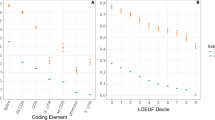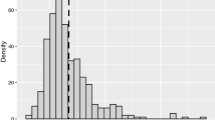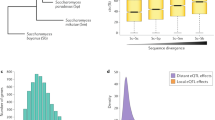Abstract
One of the long-standing mysteries of evolutionary genomics is the source of the wide phylogenetic diversity in genome nucleotide composition (G + C versus A + T), which must be a consequence of interspecific differences in mutation bias, the efficiency of selection for different nucleotides or a combination of the two. We demonstrate that although genomic G + C composition is strongly driven by mutation bias, it is also substantially modified by direct selection and/or as a by-product of biased gene conversion. Moreover, G + C composition at fourfold redundant sites is consistently elevated above the neutral expectation—more so than for any other class of sites.
This is a preview of subscription content, access via your institution
Access options
Access Nature and 54 other Nature Portfolio journals
Get Nature+, our best-value online-access subscription
$29.99 / 30 days
cancel any time
Subscribe to this journal
Receive 12 digital issues and online access to articles
$119.00 per year
only $9.92 per issue
Buy this article
- Purchase on Springer Link
- Instant access to full article PDF
Prices may be subject to local taxes which are calculated during checkout


Similar content being viewed by others
References
Sueoka, N. Proc. Natl Acad. Sci. USA 48, 582–592 (1962).
Gu, X., Hewett-Emmett, D. & Li, W. H. Genetica 102–103, 383–391 (1998).
Chen, S. L., Lee, W., Hottes, A. K., Shapiro, L. & McAdams, H. H. Proc. Natl Acad. Sci. USA 101, 3480–3485 (2004).
Lynch, M. The Origin of Genome Architecture. Sinauer Associates: Sunderland, 2007.
Rocha, E. P. C. & Feil, E. J. PLoS Genet. 6, e1001104 (2010).
Hershberg, R. & Petrov, D. A. PLoS Genet. 6, e1001115 (2010).
Hildebrand, F., Meyer, A. & Eyre-Walker, A. PLoS Genet. 6, e1001107 (2010).
Lynch, M. Proc. Natl Acad. Sci. USA 107, 961–968 (2010).
Lynch, M. et al. Nat. Rev. Genet. 17, 704–714 (2016).
Li, W. H. J. Mol. Evol. 24, 337–345 (1987).
Bulmer, M. Genetics 129, 897–907 (1991).
McVean, G. A. T. & Charlesworth, B. Genet. Res. 74, 145–158 (1999).
Raghavan, R., Kelkar, Y. D. & Ochman, H. Proc. Natl Acad. Sci. USA 109, 14504–14507 (2012).
Kelkar, Y. D., Phillips, D. S. & Ochman, H. G3 5, 1247–1252 (2015).
Marais, G., Mouchiroud, D. & Duret, L. Genet. Res. 81, 79–87 (2003).
Mancera, E., Bourgon, R., Brozzi, A., Huber, W. & Steinmetz, L. M. Nature 454, 479–485 (2008).
Galtier, N., Duret, L., Glemin, S. & Ranwez, V. Trends Genet. 25, 1–5 (2009).
Pessia, E. et al. Genome Biol. Evol. 4, 675–682 (2012).
Williams, A. L. et al. eLife 4, e04637 (2015).
Mugal, C. F., Weber, C. C. & Ellegren, H. Bioessays 37, 1317–1326 (2015).
Lassalle, F. et al. PLoS. Genet. 11, e1004941 (2015).
Lynch, M. Proc. Natl Acad. Sci. USA 109, 18851–18856 (2012).
Long, H. et al. Genome Biol. Evol. 8, 3815–3821 (2016).
McKenna, A. et al. Genome Res. 20, 1297–1303 (2010).
DePristo, M. A. et al. Nat. Genet. 43, 491–498 (2011).
Van der Auwera, G. A. et al. Curr. Protoc. Bioinformatics 43, 11.10.1–33 (2013).
Thorvaldsdottir, H., Robinson, J. T. & Mesirov, J. P. Brief. Bioinform. 14, 178–192 (2013).
Acknowledgements
Support was provided by the Multidisciplinary University Research Initiative awards W911NF-09-1-0444 and W911NF-14-1-0411 from the US Army Research Office to M.L., National Institutes of Health awards R01-GM036827 and R35-GM122566 to M.L., National Natural Science Foundation of China 31741071 to H.L., R01-GM51986 and R35-GM122556 to Y.V.B., F32-GM083581 to D.T.K. and National Science Foundation grant DOB 1442246 to J.T.L. We thank T. G. Doak, P. Keightley, K. Morris, R. Ness, I. Ruiz-Trillo, S. Simpson, W. K. Thomas, A. Uchimura and Z. Ye for providing strains and/or technical help in data acquisition. We thank L. Duret for helpful comments.
Author information
Authors and Affiliations
Contributions
H.L., W.S., and M.L. conceived and designed the study, performed the data analyses and wrote the manuscript. All authors contributed to data collection and provided input to the manuscript.
Corresponding author
Ethics declarations
Competing interests
The authors declare no competing financial interests.
Additional information
Publisher’s note: Springer Nature remains neutral with regard to jurisdictional claims in published maps and institutional affiliations.
Supplementary information
Supplementary Tables 1–6
Table 1 shows details of mutation datasets used in this study. Tables 2 and 3 list mutations from 12 microbial organisms that are first reported here. Table 4 shows results of linear regressions involving genome G/C content vs the expectations based on mutation bias. Table 5 gives parameters from regressions of selection coefficients at different genomic sites, as well as those of selection coefficients vs the mutation bias m. Table 6 shows the relationship between expression level and G/C content within 17 organisms.
Rights and permissions
About this article
Cite this article
Long, H., Sung, W., Kucukyildirim, S. et al. Evolutionary determinants of genome-wide nucleotide composition. Nat Ecol Evol 2, 237–240 (2018). https://doi.org/10.1038/s41559-017-0425-y
Received:
Accepted:
Published:
Issue Date:
DOI: https://doi.org/10.1038/s41559-017-0425-y
This article is cited by
-
Selection on synonymous sites: the unwanted transcript hypothesis
Nature Reviews Genetics (2024)
-
Spontaneous mutations and mutational responses to penicillin treatment in the bacterial pathogen Streptococcus pneumoniae D39
Marine Life Science & Technology (2024)
-
Speciation, natural selection, and networks: three historians versus theoretical population geneticists
Theory in Biosciences (2024)
-
Statistical analysis of synonymous and stop codons in pseudo-random and real sequences as a function of GC content
Scientific Reports (2023)
-
Evolution of a minimal cell
Nature (2023)



